Garmin Varia Bike Radar System In-Depth Review
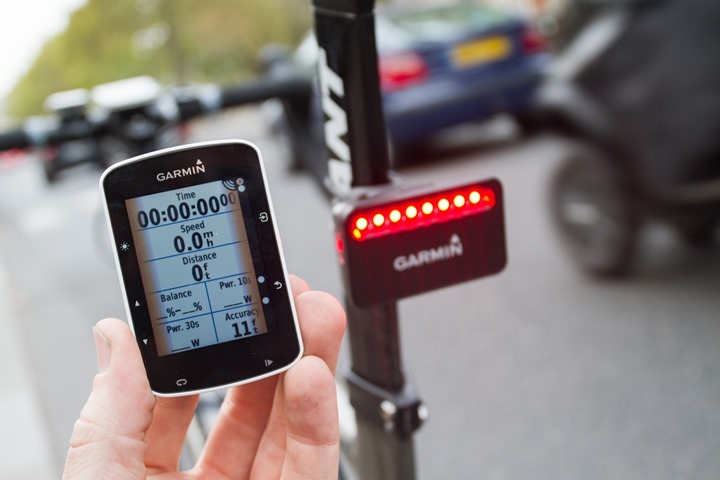
This past summer Garmin announced their foray into the cycling lights and cycling radar world. Yes, radar. They released their Varia cycling lights product line, which includes the Varia bike radar system that allows you to see approaching cars directly on a display unit or your existing Garmin Edge device. You’ll remember just a year prior I (very successfully) tested this product when it came out on a crowd-funding site. While the crowd-funding campaign fell short, Garmin scooped up the company this past winter and made quick work of getting the product to market. Since August, I’ve been using Varia in both beta and now final production form.
Now, before half of you skip to the comments to declare why bike radar is stupid without reading the post, understand two very specific statements about where I think the product works and doesn’t work:
A) Varia will NOT keep a car from hitting you as you ride down the road. Period.
B) What Varia does do VERY WELL is remind you when you’re out in the middle of nowhere with infrequent traffic and deep into exhaustion, that a car is about to approach – snapping you back to reality.
If you consider the product in those constructs, then you can approach it better as to whether the product makes sense to purchase. Got it? Good.
To be clear, I’ve been using a Varia trial bundle provided by Garmin to test with (a final production unit). Like always, I’ll be shipping that back to them in Kansas in the next little bit and going out and getting my own via regular retail channels. That’s just the way I roll.
Unboxing:
To start, Varia comes in two different varieties. You can get it with or without the front display unit. If you get it without the display unit, then you’ll need a compatible Garmin Edge device (see later section on that). Also, technically speaking there are two variants of the radar unit – the RTL500 and RTL501. The RTL500 supports both flashing and steady-light modes, whereas the RTL501 only does steady illumination (aimed at countries that don’t permit flashing lights). The prices for either variant are the same.
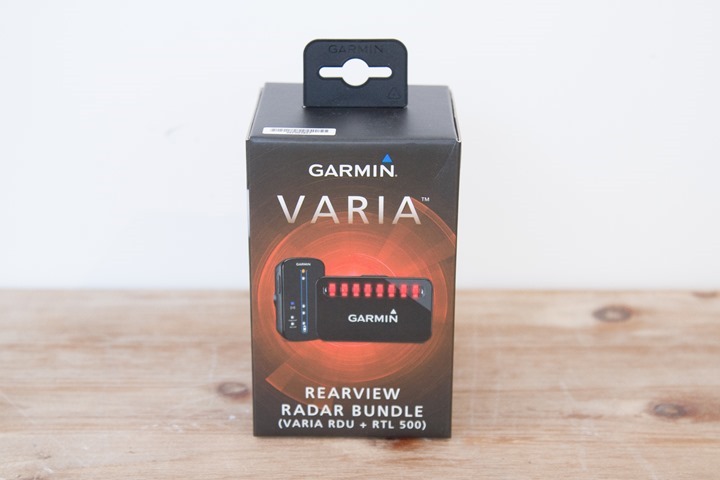
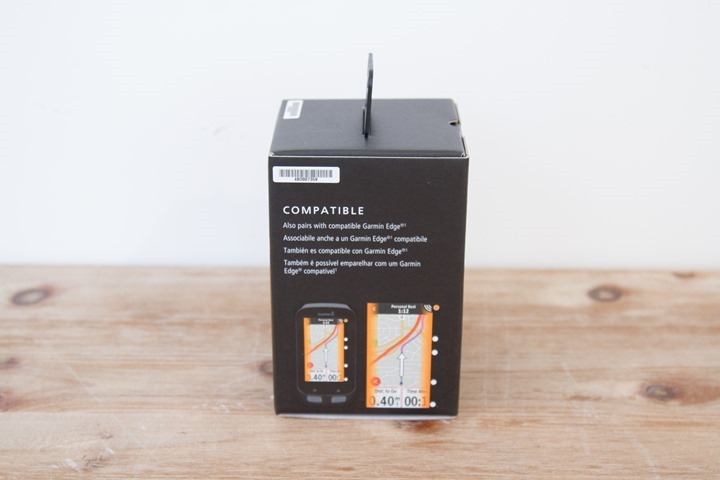
In my case I’ve got the bundled version, so that’s all the parts you’re seeing here. The main difference being that in the non-bundled version you won’t get the display unit and you won’t get the front mounts. Other than that – it’s all the same.
Here’s what’s inside the box of the bundled version:
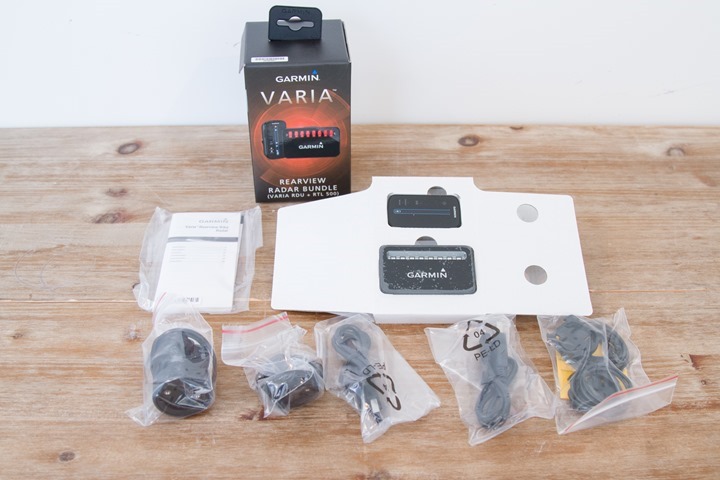
And here’s that pile of plastic goodness un-plasticized:
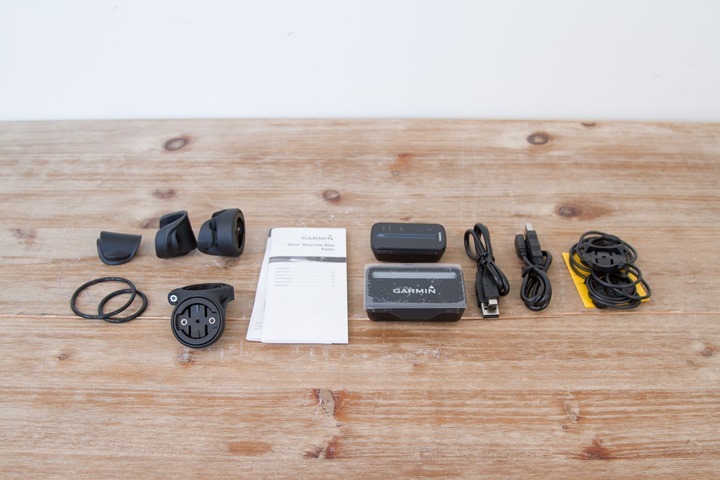
To start, you’ve got a bunch of rear radar mounts. These affix to the back of your seatpost, and have options for round seat posts as well as aero seat posts (look like a ‘v’):
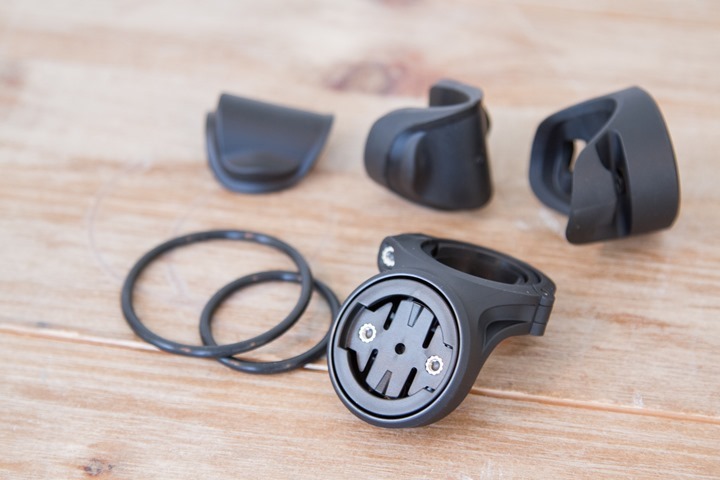
Next we’ve got the Varia radar taillight unit (RTL) and the display unit (RDU), along with their respective micro-USB charging cables:
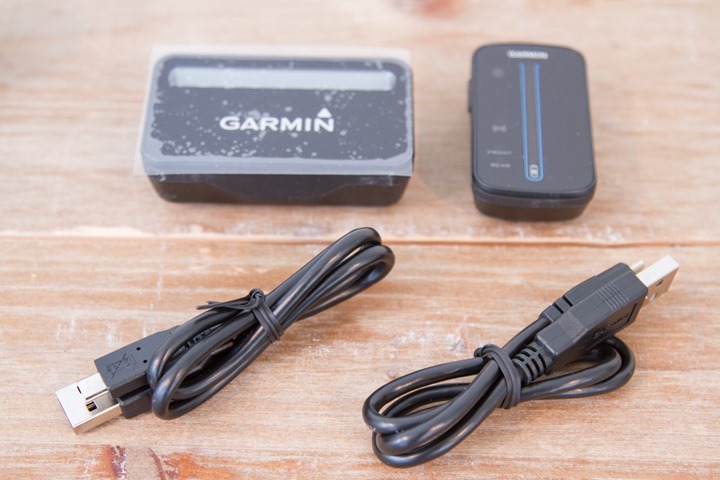
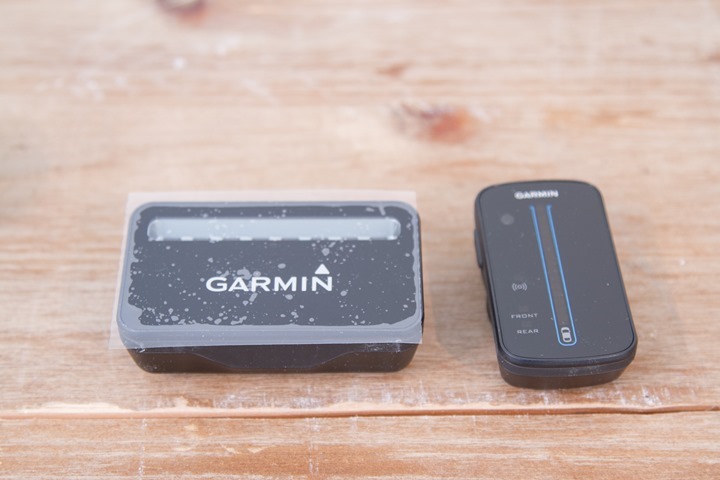
Here’s the charging cables – again, same as most non-Apple phones use:
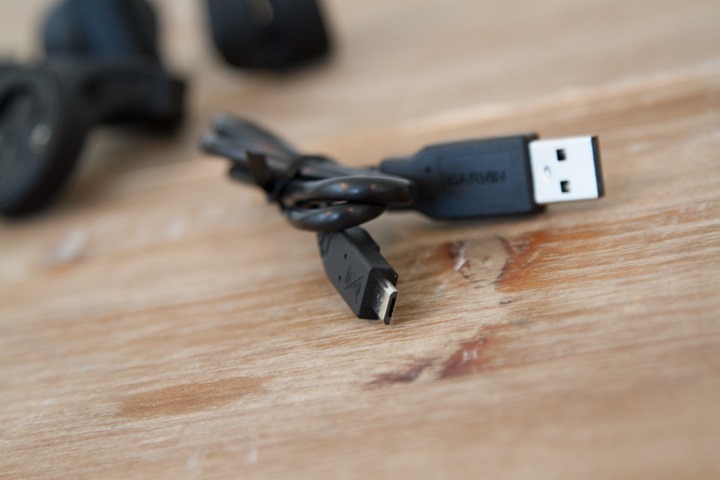
Finally, we’ve got the front display quarter-turn mounts. These are identical to those that you’d have used if you had an Edge cycling computer, to attach that to your handlebars.
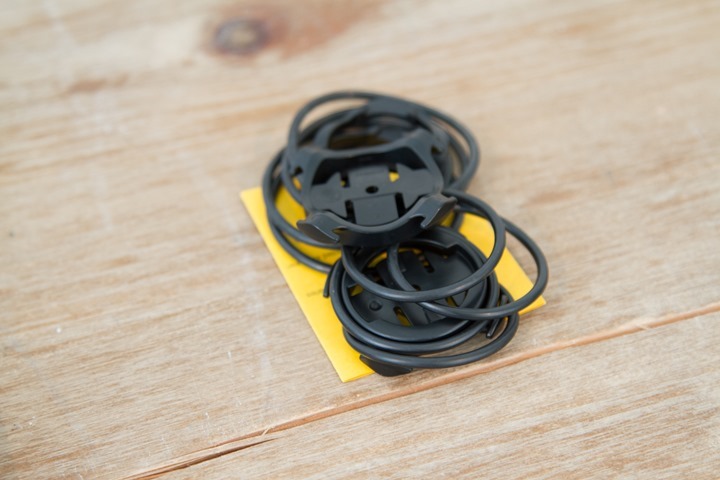
As for the weights, the rear radar is 63g, while the front display unit is 28g:
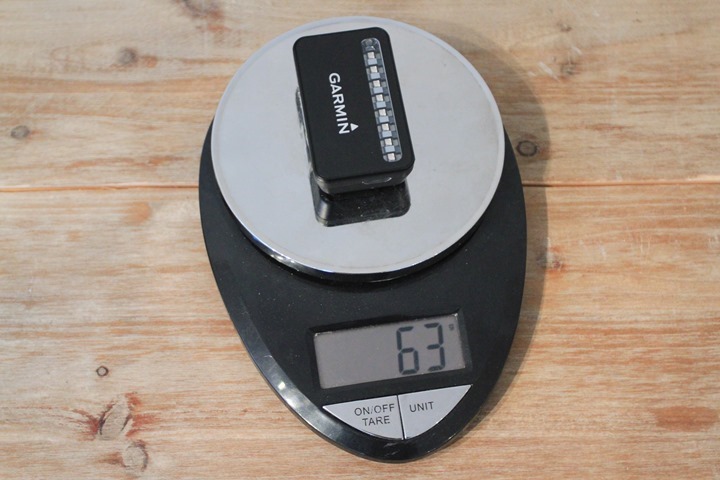
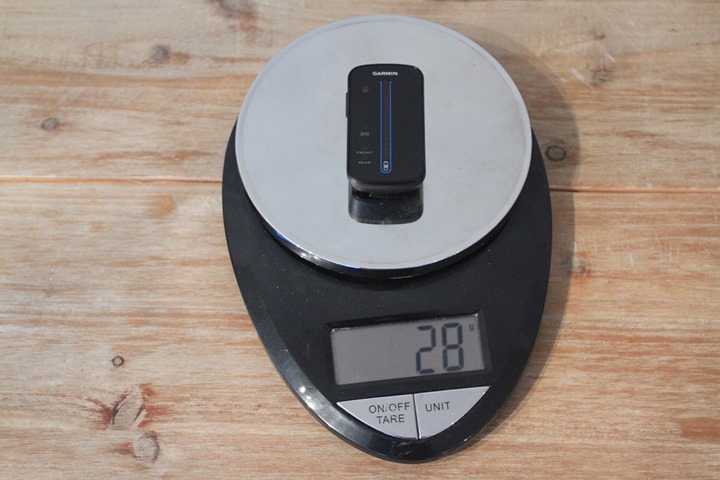
And to briefly compare sizes, here’s a look at the front display unit next to some Garmin head units. From left to right: Edge 25, Varia Rear Display Unit, Edge 520, Varia Rear Radar, Edge 810, Edge 1000:
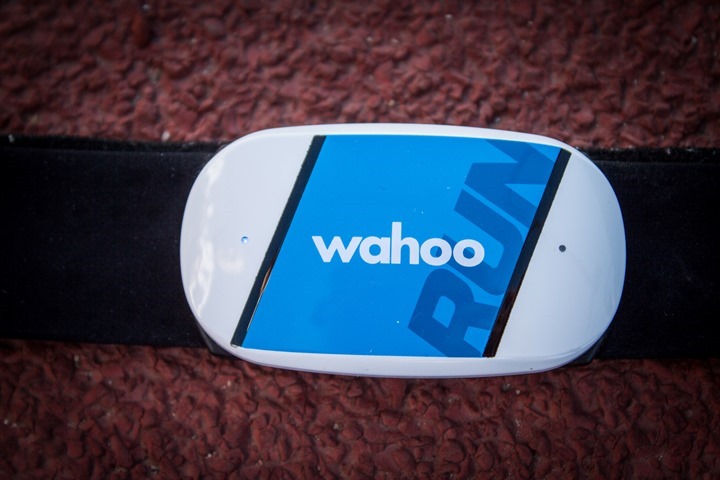
As you can see I also tossed in the rear radar light, which is roughly the size of an Edge 520 GPS.
The Basics:
In many ways, the Varia radar is one of the more simple Garmin cycling devices out there to operate – with only a few options available on it. It may transmit a lot of data, but from a ‘things to press’ kind of standpoint, it’s relatively basic (in a good way).
To start, the unit is charged via micro-USB cable (same as used on most phones these days, Apple excluded). Garmin claims a radar battery life of 10 hours (in flashing mode), or about 5 hours in always-on mode. Though validating that is tricky since factors such as traffic will play into that. Battery status is shown on the display unit, and on the Garmin Edge units.
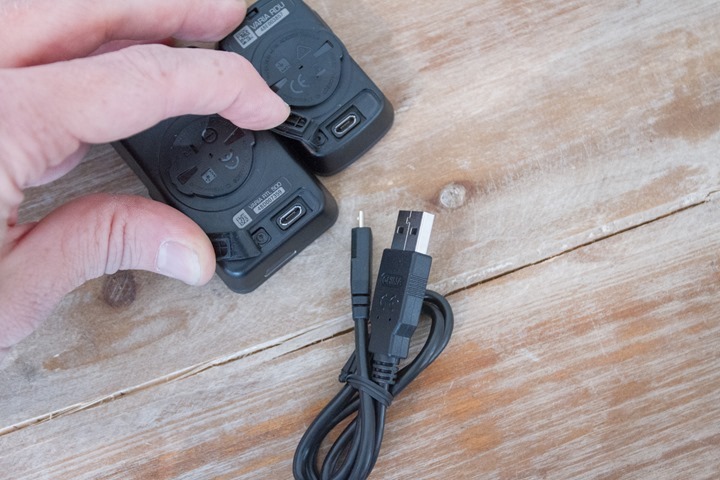
The battery is actually probably my only complaint about it. Not that it doesn’t meet the goal, but rather that I’ve had a few cases where I forgot to charge it. One handy feature though is that the latest firmware will actually turn the unit on and off automatically, based on the Garmin Edge usage – which means you won’t have to remember to do so.
Still, in the event you want to turn it on or off manually, there exists a single button on the top. This button when held down for a few seconds will power on the unit.
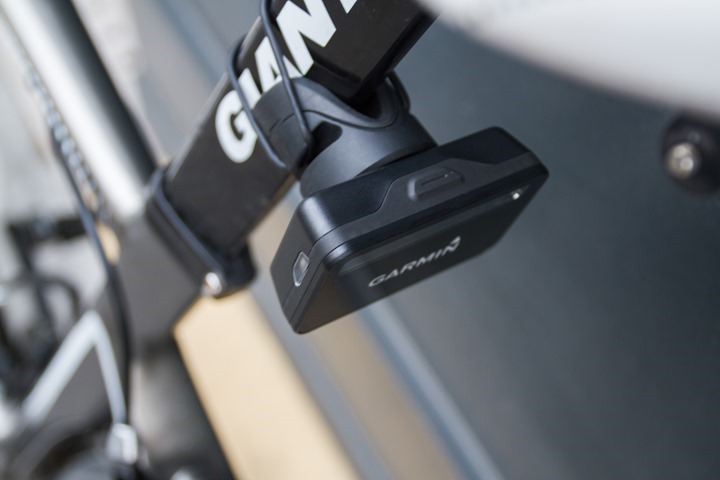
It’ll also allow you to change the light mode. One mode keeps the taillight in a ‘steady-on’ configuration, while the second mode keeps the taillight in a blinking configuration. This is required as many European countries require cycling taillights to remain in steady-on (and not blink). Meanwhile, most Americans will typically utilize the blink configuration (no regulations exist in the US around this that I’m aware of). Either way, you can simply change it by pressing the button. Alternatively, on the Edge 520/1000 you can change the light mode from ‘overdrive’ (steady-on) to flashing.
Next, when it comes to mounting, the unit uses the standard Garmin quarter-turn mount that’s been used for the last 6 years for all Garmin cycling products (except the speed/cadence & power meter sensors of course). Now, in the case of past products the mount was designed for usage on your handlebars to hold your bike computer. In this case, it’s turned on its head to mount the Varia radar (as well as the other Garmin Varia bike lights).
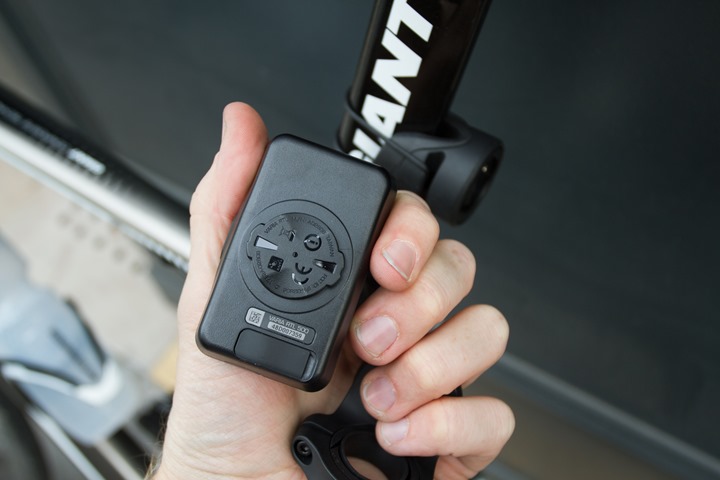
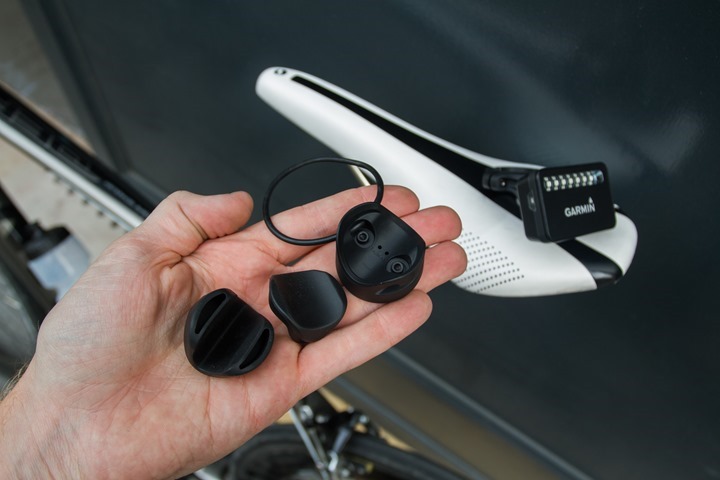
The kit as seen earlier comes with a few different seat post mounting options, depending on your seat post. For example, if you have an aero seat post, then you’ll need something more triangular in nature (which is included). Versus a round seat-post where you’ll use the…well…round, mount. The rounded mount is a bit more permanent of a mount in that you’ll use a hex wrench to install it.
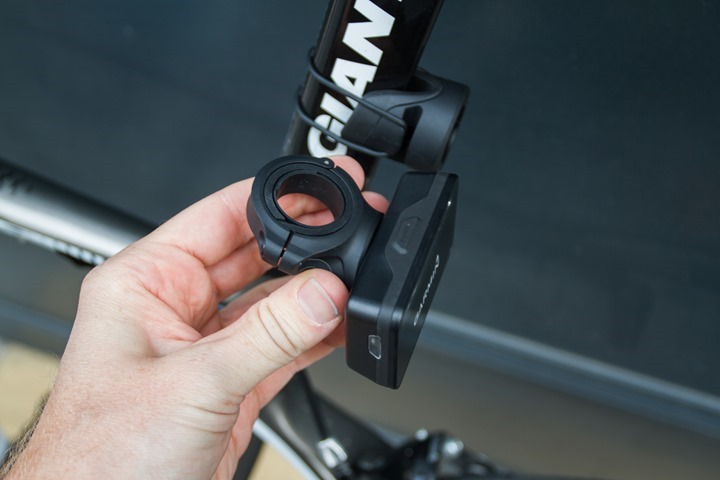
Whereas the other mounts use a slightly enlarged rubber band to hold the mount there. I never saw any issues with the rubber band variant (all my seat posts I used were of the aero variety).
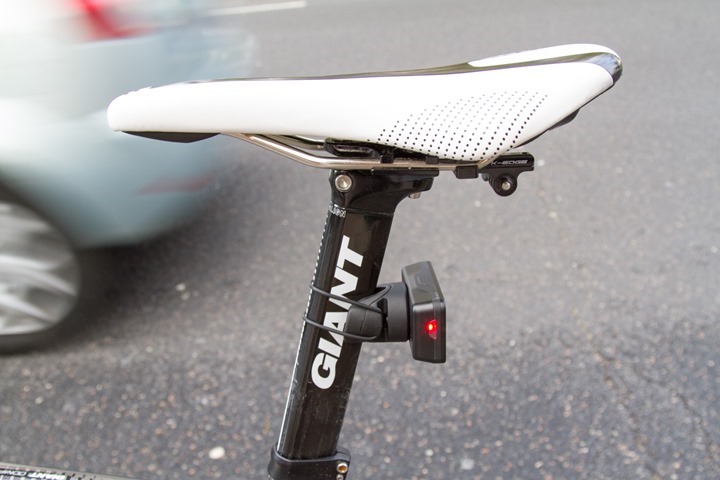
The unit doesn’t include any mounting options for mounting directly to your seat, nor anywhere else on your bike. I suspect we’ll see 3rd parties get into that space soon, especially as the Garmin bike lights release (the separate standalone lights). However, if you’re crafty, you can simply use the existing Garmin quarter-turn mounts to make your own bike mounts. I did that this past summer using a beta unit that didn’t include (yet) the official mounts:
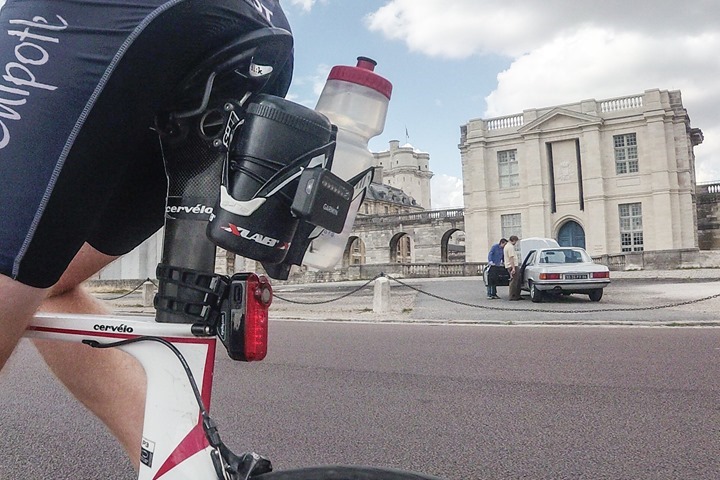
You can pickup a box of two of these mounts (and a crapton of included rubber bands) for $12, so it’s easy to toy around with creative solutions. For example, if you had more of a touring bike, you could simply glue the mount to a small metal plate (like this) and then affix that to the back of the bike. Lots of potential options here for anyone with even minimal MacGyver skills.
Standalone Display Unit:
Depending on which package you’ve purchased, you might get a Varia Radar Display Unit (RDU) in your box. This little gum pack sized piece of blinkiness alerts you to cars approaching from behind, up to some 140 meters away.
The unit works by connecting to your Garmin Varia wirelessly, and then displaying car status. The unit is charged in the same manner as the rear radar – via micro-USB. Garmin claims 10 hours of battery life on it.
Next, just like all head units Garmin makes, it too uses a quarter-turn mount. Thus you can mount it easily to anywhere on your handlebars.
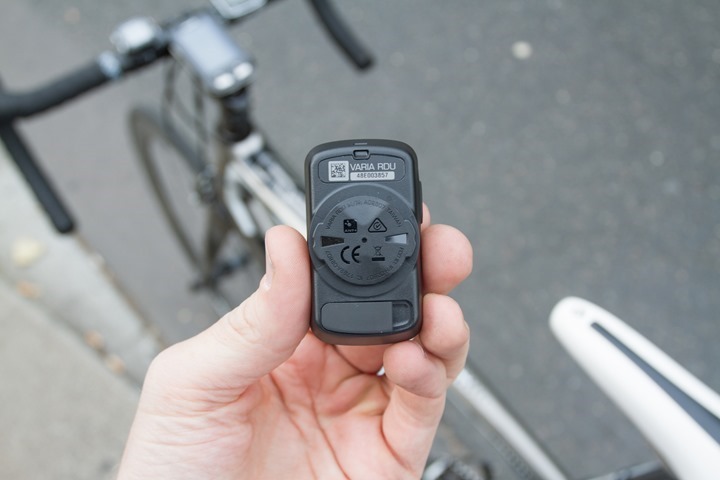
Heck, you can even mount it to a top tube of your bike. But the goal with this should be to be within your peripheral vision, as the unit oddly does not include any beep/noise function (whereas an Edge unit will). Just to re-iterate: It does not beep, buzz, or otherwise make any noise when cars approach.
Speaking of which, the unit will display a small white dot as a car approaches from behind. As the car gets closer, the white dot will ‘rise’ from the bottom of the display to the top of the display. Also, it’ll display a yellow light at the top.
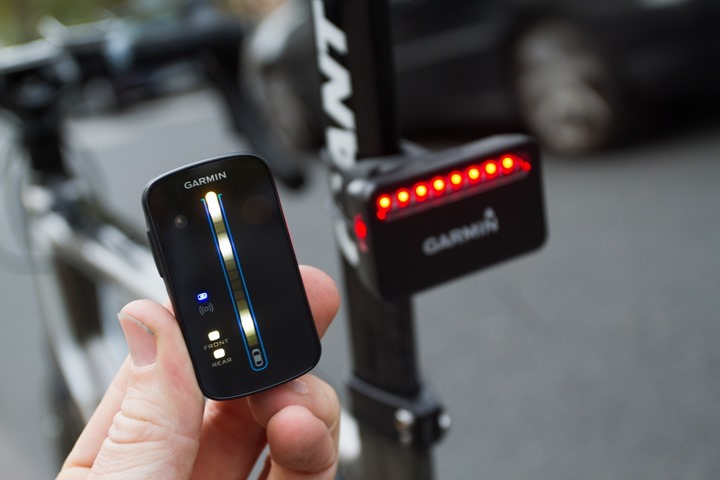
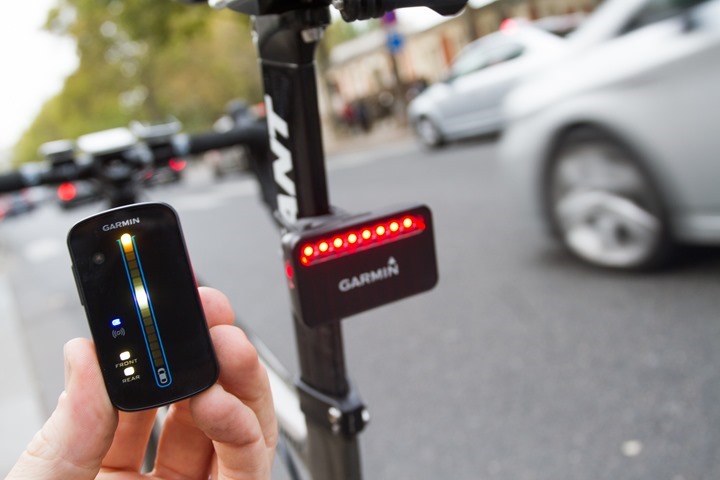
Once it reaches the top, you’ll get a small green light indicating the coast (or road) is clear.
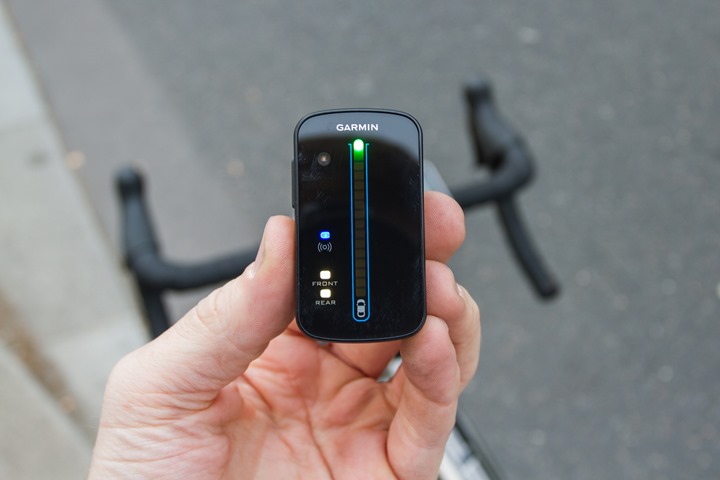
There will be multiple dots for multiple cars, such as below. The two white dots below the blue dot are for battery status. The front dot indicates the battery status of the display unit, while the rear dot indicates battery status of the radar.
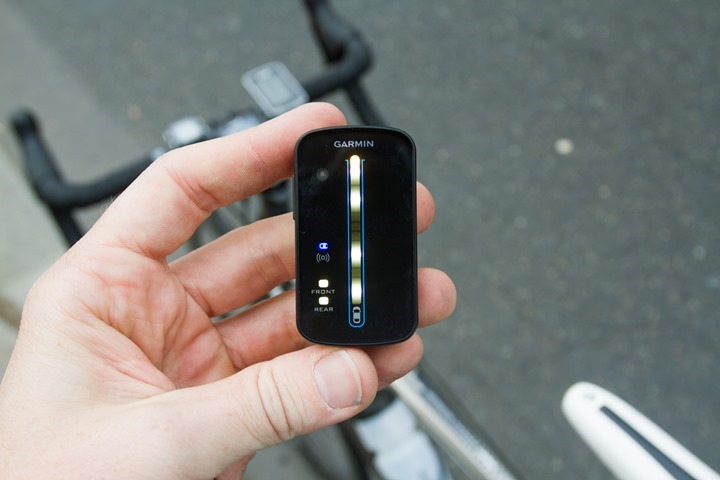
As you can see, it’s fairly darn simple. But, I believe for most people, it’s also a bit peculiar to use by itself becasue it adds more junk to your handlebars. And realistically if you’re reading this you likely already have a cycling head unit on there. So why not use that instead?
Using a Garmin Edge display:
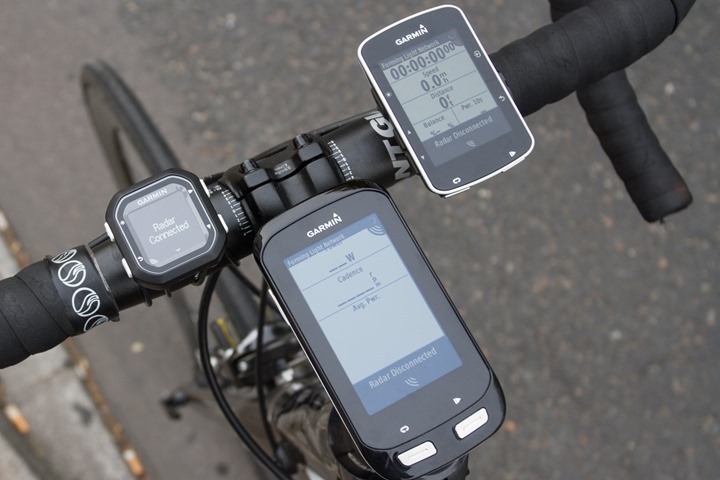
In addition to using the Garmin Varia with the included (depending on bundle purchased) display unit, you can also ditch the display unit and use it directly with your Garmin Edge device. At present, that includes the Edge 1000, Edge Explore 1000, Edge 520, and Edge 25. Down the road it’ll also include (in some manner), the Edge 510, Edge 810, and Touring Plus.
In using these devices instead, the Varia radar information will be displayed directly on the Edge. Or rather, the Edge of the Edge. The bike computers will use the sides of the Edge’s display to show you traffic information – it’s actually pretty darn cool and one of the cleanest ways to display that information that I could think of.
To do this, the Edge communicates with the Garmin Varia using ANT and ANT+. In talking with Garmin, the majority of the work they had to do after they acquired BackTracker was in converting from Bluetooth to ANT/ANT+ for the communications. You’ll note that I use both ANT and ANT+. That’s because Varia talks in two distinct ways.
First is that using ANT+ it broadcasts itself using the standard ANT+ Lighting Control. This is the same public ANT+ profile that the Bontrager ANT+ enabled light system uses (as well as Garmin’s Varia front/back lights). As such, technically speaking either product can control each other. However, the Varia radar also uses private-ANT to transmit the radar-related information, for which no public ANT+ profile exists.
I’ll start with the Edge 1000, and then show how it works briefly on the other compatible head units as well. To begin you’ll need to pair your Edge 1000 to the Varia unit. To do so simply go into the sensors menu and search for the Varia lights, just as you would for a new heart rate sensor or cadence sensor:
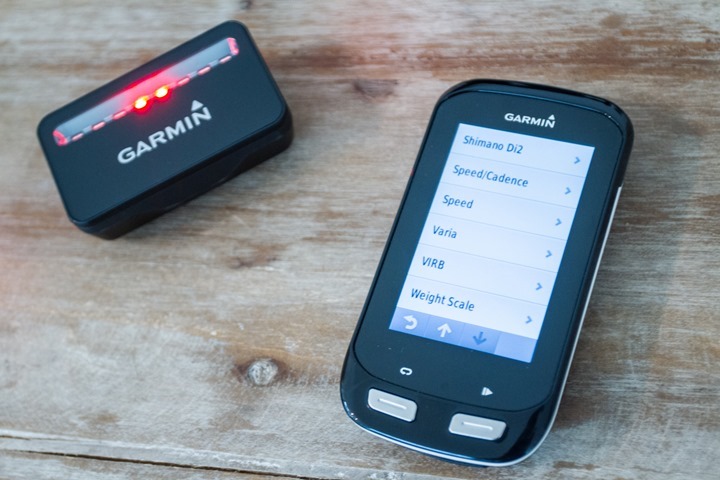
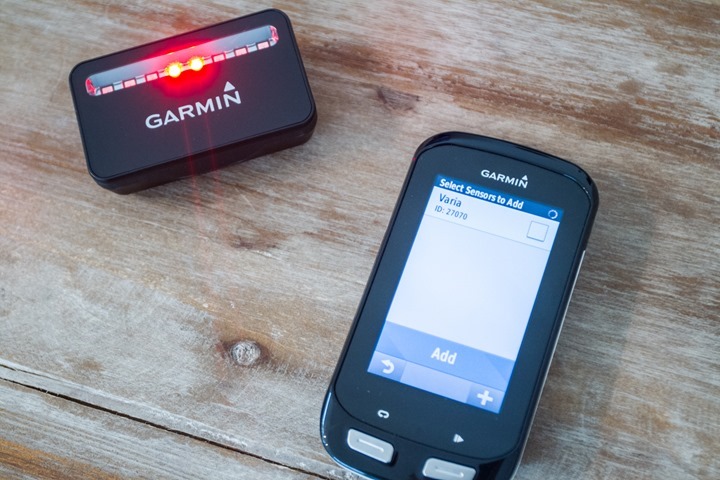
It’ll find the Varia unit and then form a ‘light network’. What this means is that all of the lights talk to each other, rather than directly to the Garmin Edge. Why do that? Well, it allows the Edge unit to only use a single ANT+ channel when talking to multiple lights. Rather than one channel per light. The Edge 1000 has 8 channels available, but those channels can quickly fill-up if you were required to have one per light (i.e. one headlight, two rear lights, plus the radar light, and then things like heart rate, speed, cadence, power, or action cam control each taking a channel). Obviously it’d be a lot of gear on your bike, but not impossibly so.
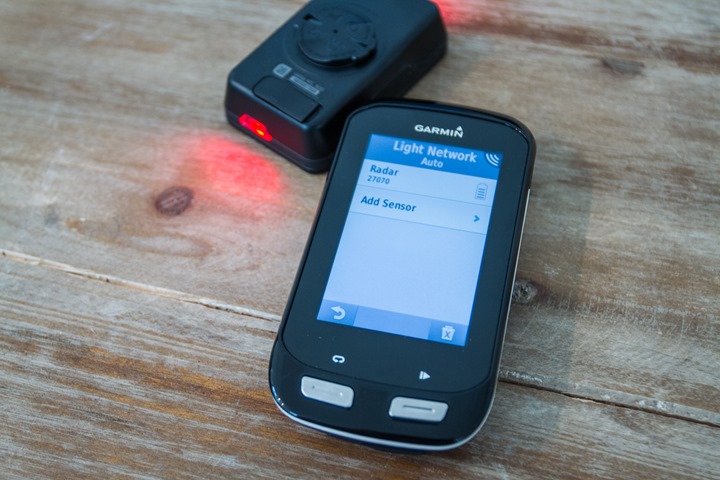
Once the light network is formed you’ll have a new menu that you can show all included lights. With just the Varia radar in there, there honestly aren’t too many options to poke at (you’ll get more options when you add in other standalone ANT+ lights):
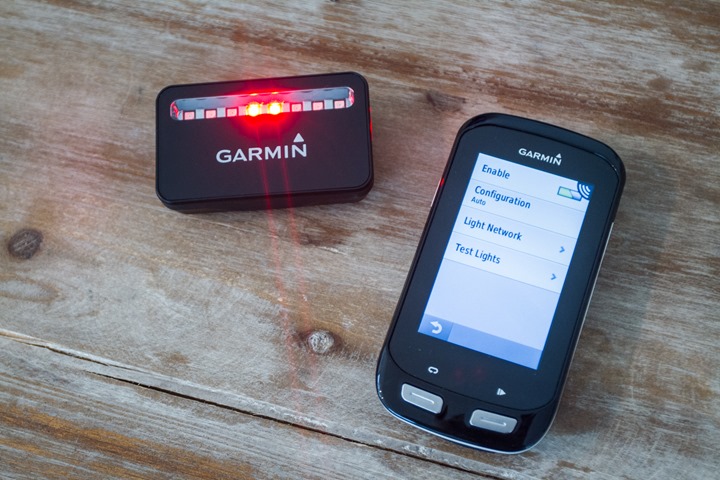
But you can use the test option to validate connectivity to the radar’s light, or change the mode from flashing to steady.
Next, if you head into the ride mode you’ll notice at the top of your screen you’ll see a little icon that sorta looks like a upside-down WiFi symbol. This is the radar symbol – and indicates that radar is connected and transmitting to your bike computer. If this disappears, it means that either the radar unit is off or fell off.
Now if riding along with no cars, you’ll see no information on the side of the screen – as to not clutter things up. But, as soon as cars come into view the Edge will chirp (beep) and display a cautionary color on the edges of the screen’s display:
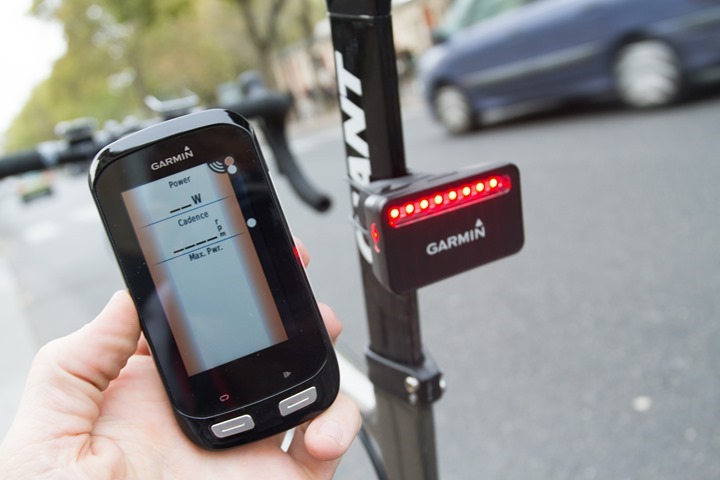
This indicates that cars are approaching from behind. Additionally, you’ll now see a small white dot on the Edge of the screen, one for each car. These dots will migrate to the top of the screen as the car approaches you. You can see in these back to back pictures (above/below) that the lower white dot is a little bit closer – I took them about one second apart (it moved from the bottom of the cadence field to the top).
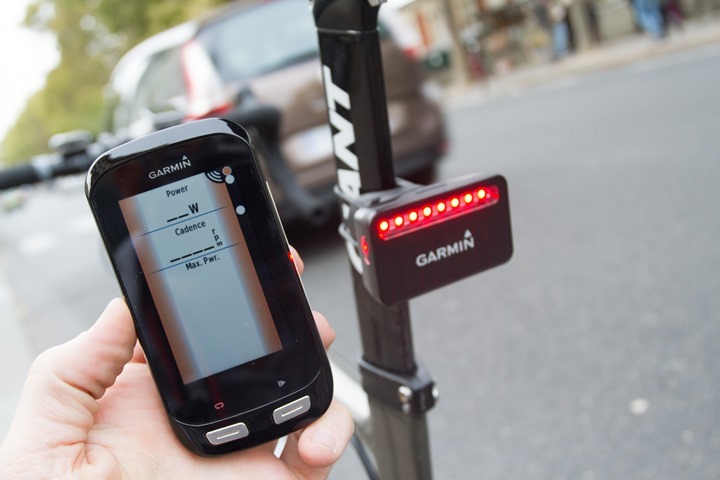
Once the cars are clear, the edge of the screen will flash a green color that indicates all is clear (and gives a slightly different ‘all clear’ beep). Eventually it’ll remove the green edge if no further cars are present:
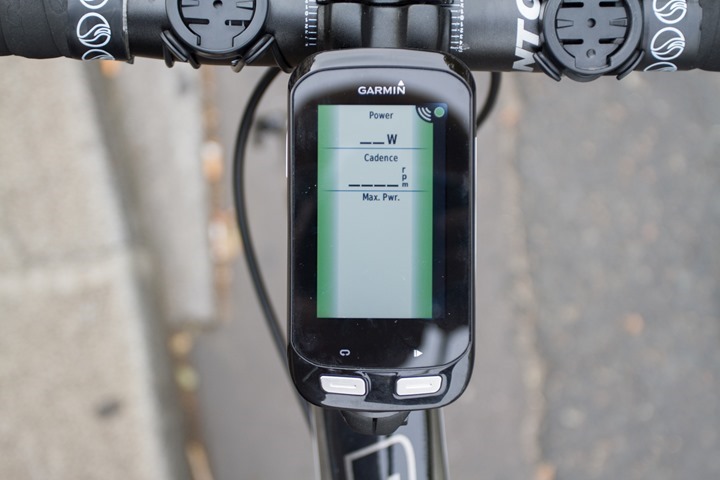
Now, there’s also the rare red color on the edge of the screen. This is for fast-moving cars, which trigger a higher ‘threat level’ than just orange/amber. Essentially this is a ‘wake up, you’re about to be overtaken by a high speed vehicle’. Again, going to the purpose of this – it’s to make you aware of that specific car. On some roads, that might be a perfectly acceptable speed for a car. Whereas on others it might be way out of the norm and an indicator that you may want to look back and see what’s up.
Now, while all of that jazz is going on up front on the display unit, the rear tail light is actually changing to react to traffic as well. As traffic gets closer the red taillight bar will ‘expand’. You can see this when I set it on a post, where the size of the light bar increases in width (in case you’re wondering why the 2nd image it doesn’t yet show a car, it’s simply because it was in the split-second before the display unit updated).
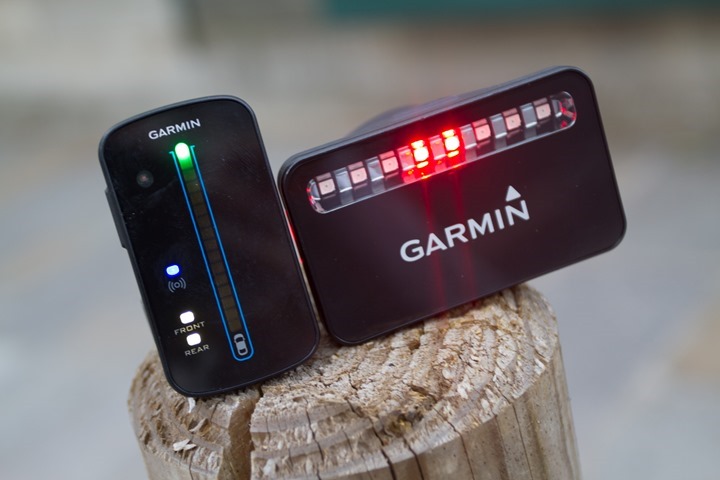
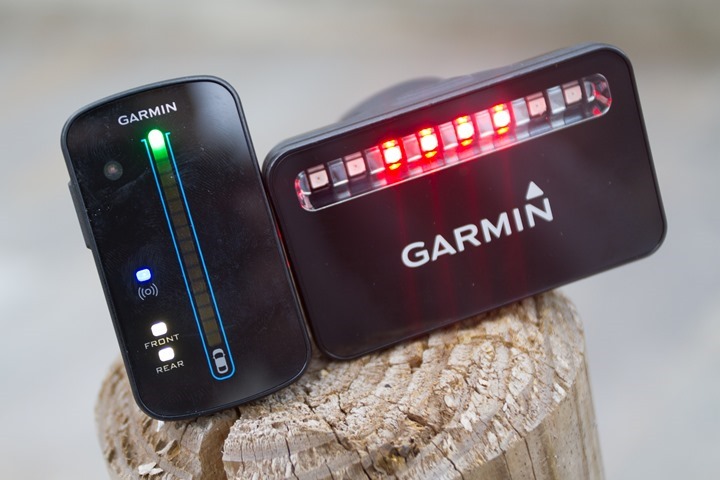
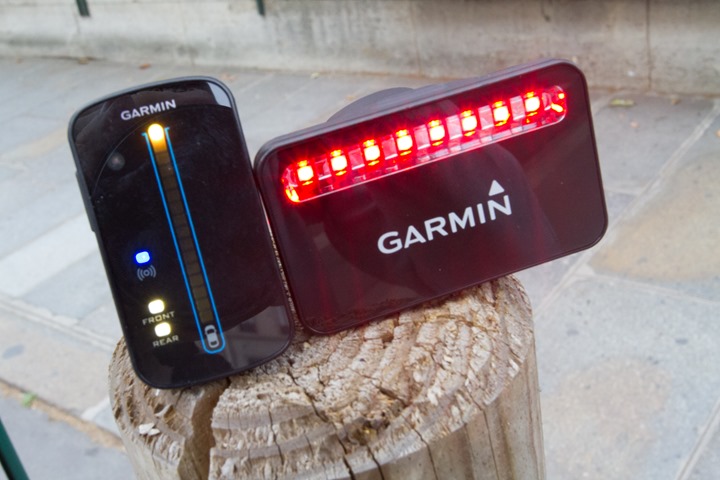
The taillight doesn’t make any sounds by itself, only your Edge unit.
Just to briefly show what the whole interaction looks like on other Edge display units, here’s a quick gallery of the Edge 520. It operates virtually identically to the Edge 1000 in this manner:
And then you’ve got the Edge 25. Now in that case things are a bit different. That’s because the Edge 25 lacks a color display, or the real estate of the larger Edge devices. So to begin, when you pair it you’ll see a little light icon displayed right before you start riding, that indicates connection:
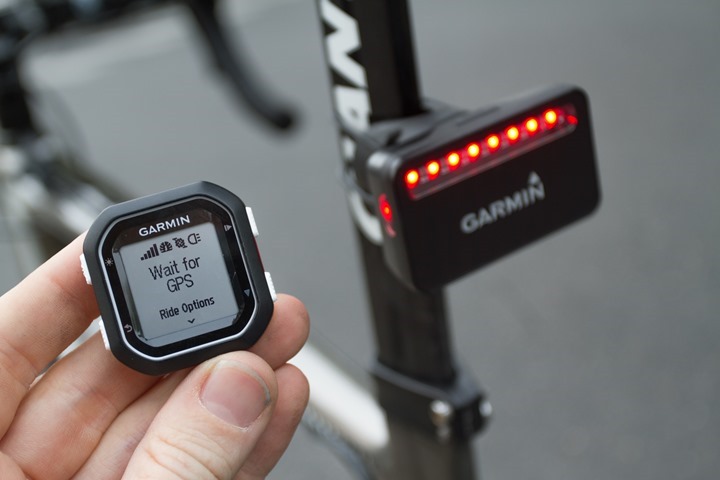
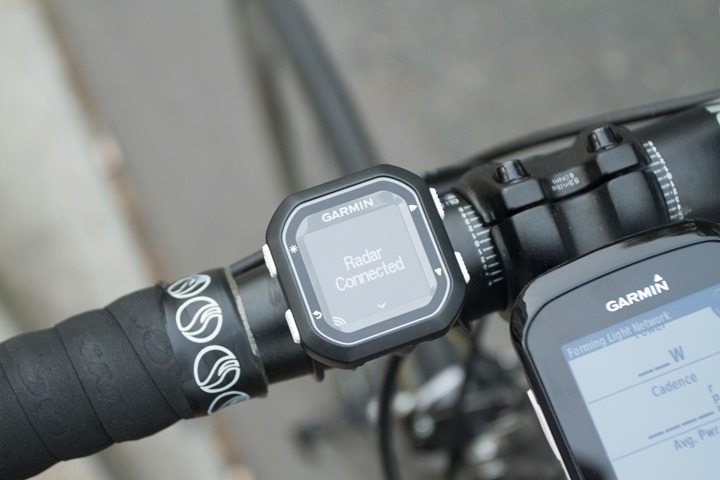
Next, as you’re riding you’ll get the left side displaying the Varia radar state of incoming traffic. Just like the other displays it shows a small moving dot for each car. And like the others it chirps when a new car shows up:
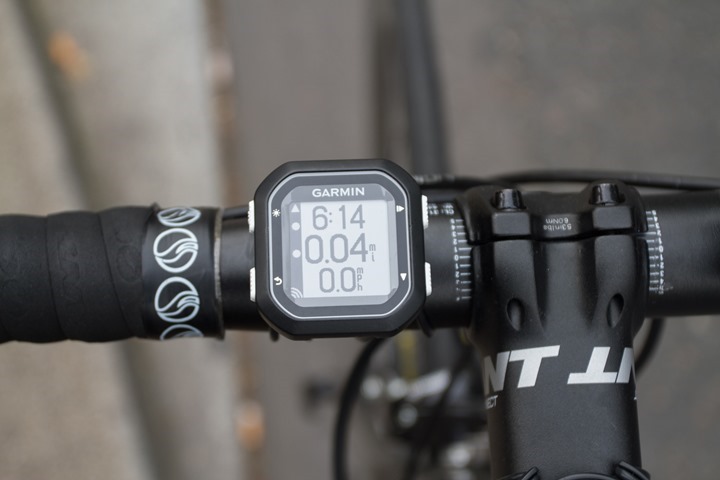
For the commuter – this is quite frankly awesome. It’s shown in such a clean and simple way, on a small unit that’s perfect for bike commuting. Of course, in high traffic city environments the Varia radar isn’t so useful as on quieter roads.
One interesting tidbit on the Edge units is that the Edge will automatically turn on the Varia lights from a power-off state when you power on the Edge unit. Essentially Varia goes into a sleep (or perhaps sleepy) state and then the Garmin device can awaken it, thus saving you from forgetting to turn it on. The inverse is also true too – when you shut off your Garmin Edge, it’ll shut off the Varia. This helps to ensure you don’t forget to turn off the radar, saving battery.
Usage Notes:
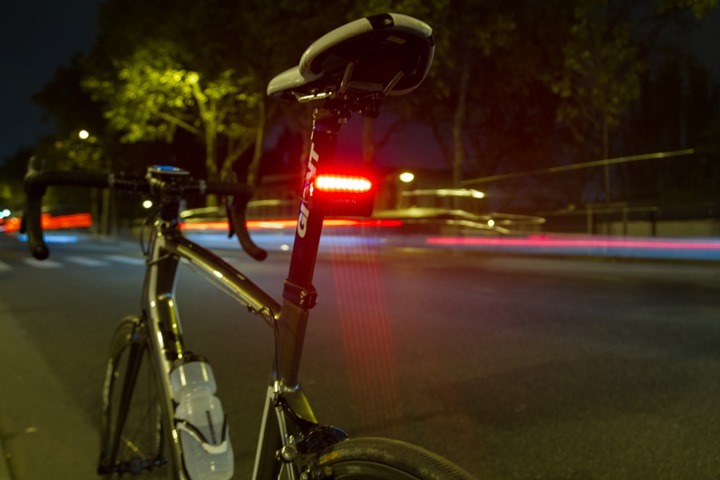
So now that I’ve talked about how it works – let’s talk about whether it works. I’ve used Varia a lot. In a lot of conditions. From the hyper-busy streets of Paris (including the famed and traffic filled Champs-Élysées), to the quiet country and suburban roads just beyond the city, to the mountains of Switzerland, Canada, and Austria. It’s gotten a lot of play on a lot of bikes over the past few months.
In general, it does an extremely good job at recognizing cars and alerting me of those cars approaching from behind (it doesn’t do anything for traffic coming from the front). Garmin has tweaked the software once already since release (the firmware can be updated), to increase sensitivity slightly – resolving some earlier oddities I saw with mopeds.
It’s important though to understand a bit on where and when Varia won’t trigger though. Here’s a bit of a list of things that don’t trigger it – starting with the obvious:
– It won’t trigger when you pass a tree, light pole, or statue
– It won’t trigger when you pass parked cars, trucks, airplanes, or blimps (yes, I’ve tried)
– It won’t trigger when another cyclist is riding with you, or even a few cyclists riding with you
– It won’t trigger for traffic coming from in front of you (other oncoming, or just in front of you going the same way)
– It won’t trigger for any car going below 6MPH (10KPH) or going above 99MPH (160KPH)
– It won’t show more than 8 vehicles concurrently
There are then some cases it might not always trigger:
– I’ve seen cases where when a car pulls out from a side-road (perpendicular) onto a street behind you and matches your speed, it might not catch it.
– When there are multiple cars that are perfectly aligned behind each other, it’ll only show a single car. However, once the first car passes or moves, it’ll then show you the second car still there.
– Sometimes it doesn’t always catch smaller mopeds going the same speed – though, it appears the latest firmware updates seems to have resolved that for me. Larger motorcycles are no issue.
– Sometimes it won’t show cars that stay the exact same speed as you for prolonged periods of time. Essentially these appear to drop-off the radar, even though they might be there. For example, if both you and the car are going 18MPH, and doing so for 10 seconds, the car might disappear from view. Once the car increases speed to overtake, then it shows back up again.
Finally, there are some cases that I should note:
– If you’re standing on the side of the road, it will sometimes trigger on approaching cyclists. Not all cyclists, but it appears to be those cyclists with larger bikes. For example in Paris it’ll almost always trigger on an approaching Velib (bike sharing bike) when I’m stationary, but not so much on a single-speed bike. Not sure this matters, but just a fun observation.
– Once a car decelerates, it disappears from view. Meaning, if the car stops on the road and you continue – it’ll drop off the radar. Logical, but figured I’d point it out.
Now, are any those scenarios deal breakers? In most cases no. They represent low-risk situations as far as I can see, because the cars in question aren’t overtaking you (yet), but rather maintaining speed.
So where is it most useful? For me – it’s on roads where traffic is infrequent and where my speeds may be high enough that the wind noise makes it impossible to hear approaching cars. An example would be descending, or just on a windy day out on country roads. One specific example was when I was riding in the Austrian Alps I was descending at relatively quick speeds on winding roads. Yet, many drivers in that region will drive exceedingly fast through the twisty routes – far faster than I could bike descending. And, they’ll also overtake bicycles as soon as possible (good idea or otherwise).
In this case it was often hard to hear approaching cars, but the radar picked them up quite nicely – giving me a tiny bit of warning on roads that I otherwise wanted to fully concentrate on my handling. I found a similar scenario while riding out on rolling country roads on a windy day – where I couldn’t hear approaching cars that were few and far between. This reminded me to get closer to the side of the road.
For those looking for a bit of an on-road demonstration of how it works, here’s a video I did this summer that walks through usage on the Garmin Edge 1000 and the Varia Radar:
Finally, one reader recently posted a comment on my preview post about a unique scenario that he uses Varia in, which I thought was interesting:
“The guys I ride with like it as well mainly because when I’m in front of them they know when the traffic is coming up because of the light flash variations. It’s just nice to have that extra level awareness.” – Jerry (Oct 14th, 2015)
Definitely an interesting case I hadn’t even considered – and, I think the first time I’ve ever directly quoted a reader in a review too!
Frequently Asked Questions:
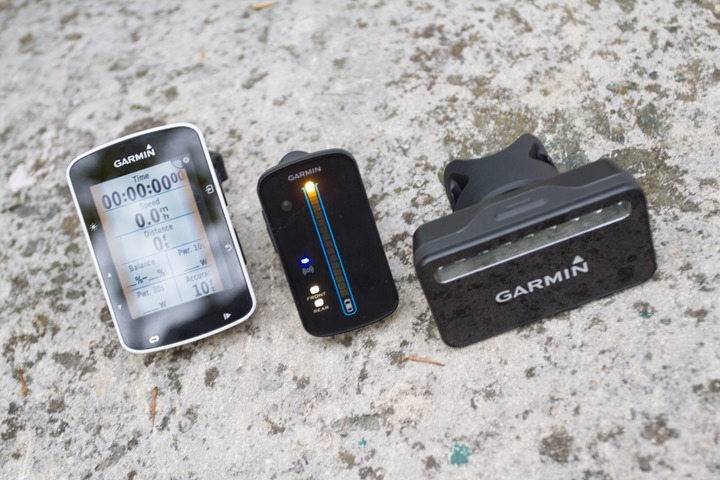
Here’s a round-up of questions that I commonly see around the Varia radar.
Will the Varia prevent a car from hitting me?
Simply put: No. But, it may prevent a car from hitting you if you’re the one that’s not paying attention. It won’t prevent a car from hitting you if you’re on the side of the road minding your business and a car crosses the line and hits you. But if you’re out in the middle of the lane on a quiet road somewhere and don’t realize a fast approaching car behind you – it may give you just that little bit of warning to get out of the way and onto the shoulder area (or edge of the road).
Can Varia be used as a standalone taillight?
Sure. It’s not the brightest of bike lights in daytime, but is more than functional as a taillight at night.
Can you change from blinking to steady-on mode?
Yes, you can change to and from either mode by using the button on the Varia radar.
Can Varia be used with more than one display unit at once?
Yes, you can actually pair it to more than one Edge unit (or an Edge + the Varia Display unit). During testing I often did that, just to see if there were any differences. This could also be interesting for tandem bikes where each rider has their own head unit.
Can you put the radar on the front of the bike?
Sure, but it’s going to basically just show you traffic that you can already see. And it probably would be rather un-aerodynamic facing forward.
Final Thoughts:
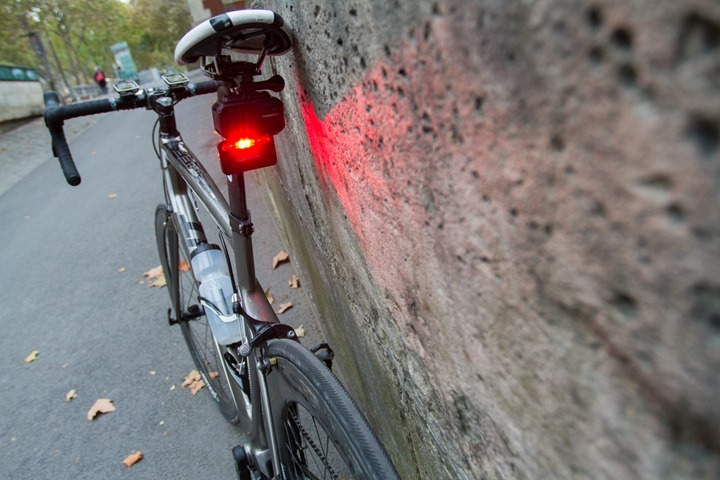
I suspect that Varia is one of those products that a small number of cyclists will love to hate on. They’ll see it as a useless piece of tech that doesn’t save the cyclist from being hit, and otherwise just a waste of money. But in a Venn diagram those people would likely near completely overlap with those that haven’t actually used it. Interestingly, in watching feedback on my Varia radar preview post from those that have bought and used the product (you) – they’re generally quite happy with it.
Which, is actually what I’d say as well. No, it won’t keep that car from hitting you – but it will keep you aware at a time you’re not paying attention. It’ll snap your focus back when you’re 4 hours into a hard ride on a quiet country rode and a fast moving car approaches from behind. Perhaps you’ve lost focus a bit and are more towards the middle of the lane – this will remind you to get to the edge of the lane or the shoulder. And that tiny reminder just might save your life when some motorist is texting on their phone and doesn’t look up to see you there in their lane.
From a technical standpoint, the unit is well implemented and really nails the experience of what it should be – but especially so when used with a Garmin Edge devices. I personally wouldn’t bother to purchase the bundled version (with the dedicated display that’s $299USD), but rather would only buy the single radar portion ($199USD) and use it with a supported Edge device. I think it’s just way cleaner on the handlebars and beeps too (unlike the dedicated Varia display unit).
I’d also note that I don’t think it’s entirely useful in a city environment since it beeps constantly, but out in the country and on quieter roads? Absolutely – for that it’s great.
Found this review useful? Or just want a good deal? Here’s how:

Hopefully you found this review useful. At the end of the day, I’m an athlete just like you looking for the most detail possible on a new purchase – so my review is written from the standpoint of how I used the device. The reviews generally take a lot of hours to put together, so it’s a fair bit of work (and labor of love). As you probably noticed by looking below, I also take time to answer all the questions posted in the comments – and there’s quite a bit of detail in there as well.
I’ve partnered with Clever Training to offer all DC Rainmaker readers exclusive benefits on all products purchased. By joining the Clever Training VIP Program, you will earn 10% points on this item and 10% off (instantly) on thousands of other fitness products and accessories. Points can be used on your very next purchase at Clever Training for anything site-wide. You can read more about the details here. By joining, you not only support the site (and all the work I do here) – but you also get to enjoy the significant partnership benefits that are just for DC Rainmaker readers. And, since this item is more than $75, you get free 3-day (or less) US shipping as well.
Garmin Varia Radar Tail Light – select dropdown for model
Garmin Varia Radar Bundle With Display Unit – select dropdown for model
Additionally, you can also use Amazon to purchase the Varia (though, no discount). Or, anything else you pickup on Amazon helps support the site as well (socks, laundry detergent, cowbells). If you’re outside the US, I’ve got links to all of the major individual country Amazon stores on the sidebar towards the top.
Thanks for reading! And as always, feel free to post comments or questions in the comments section below, I’ll be happy to try and answer them as quickly as possible.











